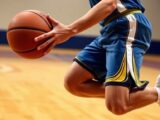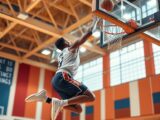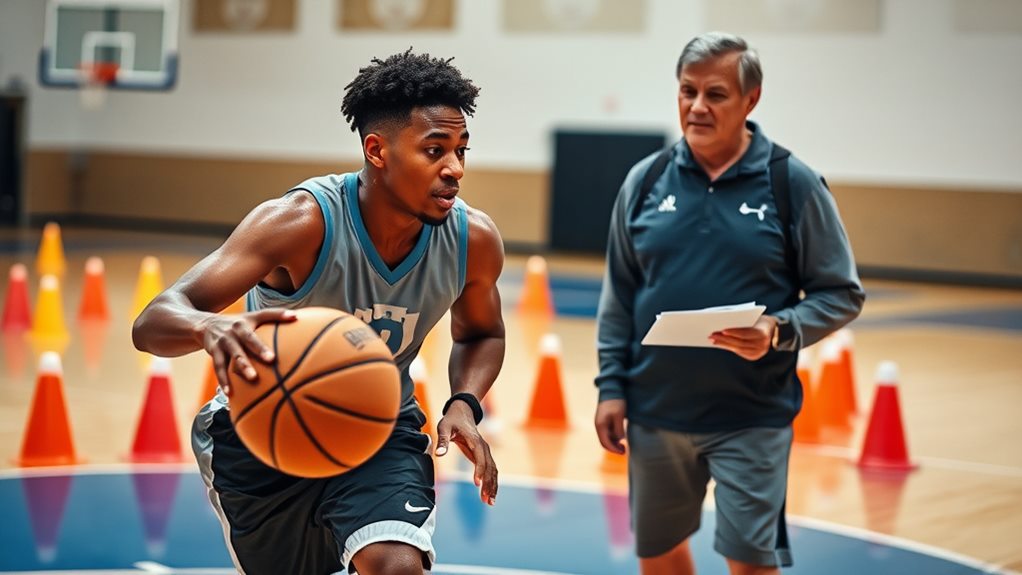
Mastering Ball Handling Drills in Basketball
December 2, 2024Mastering ball handling drills in basketball is essential for your success on the court. Start with fundamental techniques, focusing on balance and posture, and practice dribbling with your fingertips to enhance control. Incorporate warm-up exercises, like ball slaps and figure 8 dribbles, to build strength and coordination. As you progress, try drills like two-ball dribbling and speed dribbling to improve rhythm and endurance. Regular assessment of your skills helps track progress and identify areas for improvement. By sticking to a practice routine and challenging yourself, you'll reveal advanced techniques and elevate your game considerably. There's so much more to explore.
Importance of Ball Handling
Mastering ball handling is essential for any basketball player looking to excel on the court. Ball handling is vital for maintaining possession and executing your offensive strategies effectively. It directly influences your ability to navigate the court under pressure, allowing you to create opportunities for yourself and your teammates.
With the integration of data-driven strategies, players can analyze their dribbling patterns and improve their efficiency during gameplay.
When you consistently practice ball handling, you enhance your court vision and decision-making skills. This means you'll make quicker, more effective plays during games, which can be the difference between winning and losing. Developing strong ball handling skills also builds your confidence. Proficient dribbling gives you better control over the game and enables you to execute advanced moves with ease.
Good ball handling requires a combination of balance, coordination, and muscle memory. You can develop these elements through regular and focused drills designed to improve your skills.
Remember, mastering ball handling is fundamental for all players, regardless of skill level. It lays the groundwork for more complex offensive techniques and overall gameplay improvement.
Fundamental Techniques
To master ball handling, you need to focus on balance and posture, keeping your knees bent and chest upright.
Adopting effective ball-handling techniques is essential, especially in today's game where defensive role evolution emphasizes the need for players to be adept at handling the ball against versatile defenders.
Dribbling with your fingertips instead of your palm gives you better control, allowing for quicker reactions.
Plus, keeping your head up while you dribble enhances your court awareness, helping you make smarter decisions in the game.
Balance and Posture Importance
Effective ball handling relies heavily on the balance and posture you maintain during play. To achieve this, keep your knees bent and your chest upright. This stance provides better control and stability as you move, allowing you to react quickly to defenders.
Maintaining an upright posture also means keeping your head up, which enhances your court awareness. You'll be able to make quicker decisions while dribbling, essential for outsmarting opponents.
Incorporating your arms effectively while dribbling further supports your balance. It reduces unnecessary body movement, leading to more precise ball handling. Remember, dribbling isn't just about your hands; it's a full-body action.
Don't forget that embracing mistakes is part of the learning process. When you focus on maintaining proper balance and posture, you'll reduce the fear of failure, which is critical for skill development.
The more you practice with your knees bent and your body positioned correctly, the more natural it will feel. Ultimately, mastering your balance and posture sets the foundation for becoming a proficient ball handler on the court.
Dribbling With Fingertips
Dribbling with your fingertips is a game-changer when it comes to ball control and precision. By using your fingertips instead of your palms, you enhance your sensitivity to the ball's movements, allowing for quicker reactions and more accurate ball dribbling.
To maximize this technique, keep your chest upright and knees bent. This posture not only supports better balance but also aids in maintaining stability while you navigate the court.
Regular fingertip dribbling drills are essential for building muscle memory. As you practice, you'll find it easier to execute complex moves during game situations. Remember, embracing mistakes is part of the learning process. Each error is an opportunity to improve your ball-handling skills and build confidence.
As you continue to perfect your fingertip dribbling, you'll notice that you're less inclined to look down at the ball. This shift in focus is vital for improving your overall game, as it allows you to keep an eye on your teammates and opponents.
Enhancing Court Awareness
A key element in becoming a better basketball player is enhancing your court awareness. To do this, avoid looking down at the ball while dribbling. Instead, keep your eyes up to observe your teammates and defenders. This allows you to make quicker decisions and find openings on the court.
Maintaining an upright chest and a balanced stance with bent knees is essential for effective court vision.
When you dribble, focus on using your fingertips rather than your palms. This gives you better control and quicker reactions to movements around you. Additionally, incorporating head fakes and body movements while handling the ball can mislead defenders and create space for yourself or your teammates.
Regularly practice drills that emphasize keeping your eyes up, allowing you to develop strong court awareness. For instance, try dribbling the ball back and forth while maintaining your focus on the court. This helps you connect your ball handling with your ability to read the game.
With consistent practice, you'll find that enhancing your court awareness greatly improves your overall performance on the court.
Warm-Up Exercises
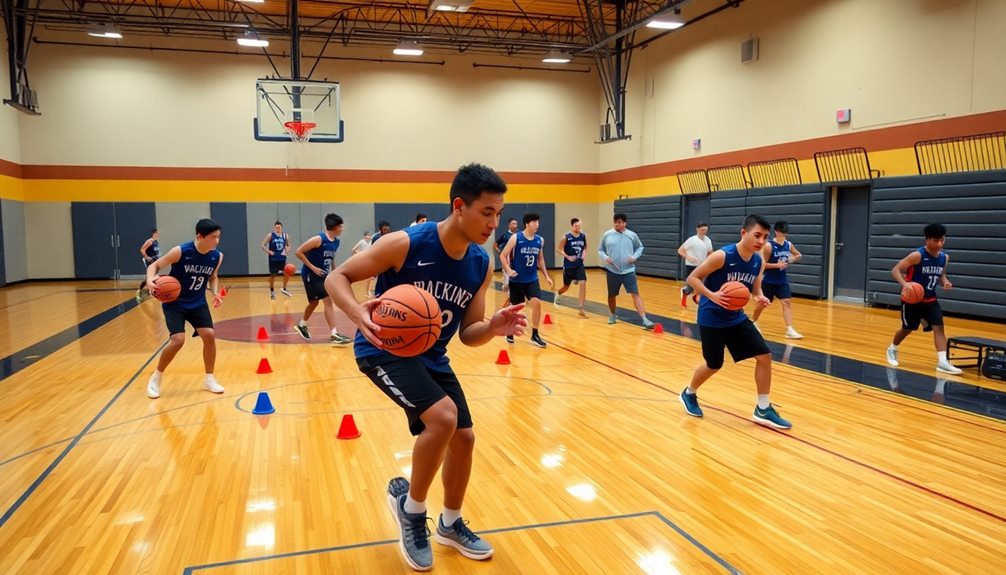
Warm-up exercises are essential for enhancing your ball-handling skills and preparing your body for the demands of basketball. These exercises not only warm up your muscles but also help establish muscle memory, which is vital during practice and gameplay. Just like in soccer, where players must adhere to specific rules and maintain sportsmanship, incorporating a structured warm-up routine can greatly improve your performance on the court field dimensions and equipment requirements.
Start with ball slaps, alternating between slapping the ball with one hand while holding it with the other. This builds hand strength and connection with the ball.
Next, try the fingertips exercise, pushing the ball back and forth with your fingertips at varying heights, from overhead to ankle levels, helping you refine control.
The wraps drill is another great addition; wrap the ball around your head, waist, and ankles to improve coordination and control.
Finally, incorporate the figure 8 drill, where you dribble the ball around your legs in a figure 8 pattern. This reinforces coordination and enhances your muscle memory for effective ball handling.
As you perform these warm-up exercises, remember to maintain an athletic position—knees slightly bent, feet shoulder-width apart, and ready to move. This will set the foundation for more advanced ball-handling drills and improve your overall performance on the court.
Key Ball Handling Drills
Now it's time to focus on key ball handling drills that can elevate your game.
Incorporating cardio workouts into your training regime can further enhance your agility and endurance, which are vital for effective ball handling.
You'll explore essential dribbling techniques, skill-building drills, and advanced exercises that push your limits.
Essential Dribbling Techniques
Mastering essential dribbling techniques is vital for any basketball player looking to elevate their game. To effectively dribble the ball, you need to maintain balance with bent knees and an upright chest. This posture gives you better control and allows you to react swiftly.
Instead of using your palms, focus on dribbling with your fingertips. This enhances your control and responsiveness, making it easier to navigate through defenders.
Incorporate drills like the pound dribble and figure 8 dribble into your routine to develop muscle memory and coordination. These exercises are invaluable for building the fundamental skills needed for successful ball handling.
Additionally, practice incorporating changes of pace and fakes while you dribble the ball. This can confuse defenders and create scoring opportunities during a game.
Don't forget the importance of stationary dribbling techniques, such as crossovers and behind-the-back moves. Regular practice of these skills strengthens your arms and wrists, which are essential for maintaining control in dynamic situations.
Skill-Building Drills
Improving your ball-handling skills goes hand in hand with dedicated drills that build on your foundational techniques. One effective drill is the Pound Dribble, where you dribble hard with one hand, keeping the ball low for 30-45 seconds. This drill focuses on control before switching hands, enhancing your overall ball-handling skills.
Another excellent exercise is 2 Ball Dribbling. By dribbling two basketballs simultaneously, you promote rhythm and coordination, essential for multitasking under pressure.
Next, try the Single Leg Dribbling drill, which involves circling the ball around each leg with the corresponding hand. This improves coordination and develops your balance, both critical for effective ball-handling.
The Figure 8 Dribble also works wonders, as you dribble the ball in a figure 8 pattern around your legs, reinforcing coordination and enhancing your ball-handling technique.
Lastly, incorporate Speed Dribbling into your regimen. Focus on dribbling at maximum speed while maintaining control, crucial for executing fast breaks and making quick decisions while in motion.
These skill-building drills will greatly elevate your ball-handling game!
Advanced Ball Handling Exercises
Advanced ball handling exercises are essential for players looking to elevate their game. Incorporating drills like double crossovers and in-between crossovers develops your ability to control the ball with both your left hand and right hand. Make sure you maintain a defensive stance and rhythm during these drills to enhance your balance and coordination.
One effective drill is the rhythm dribble, where you alternate front-back dribbles. This helps you create space and see the floor better, allowing you to change directions quickly under pressure. You can stack multiple advanced drills into a single workout session to build muscle memory and adaptability.
Don't forget to practice drills with counts of two, like "pop one two." This reinforces your timing and encourages a consistent pace while handling the ball.
By regularly incorporating these advanced exercises into your training routine, you'll develop high-level skills and improve your reaction times. Mastering these techniques won't only make you a more versatile player but also prepare you for executing complex maneuvers fluidly during games.
Practice Philosophy
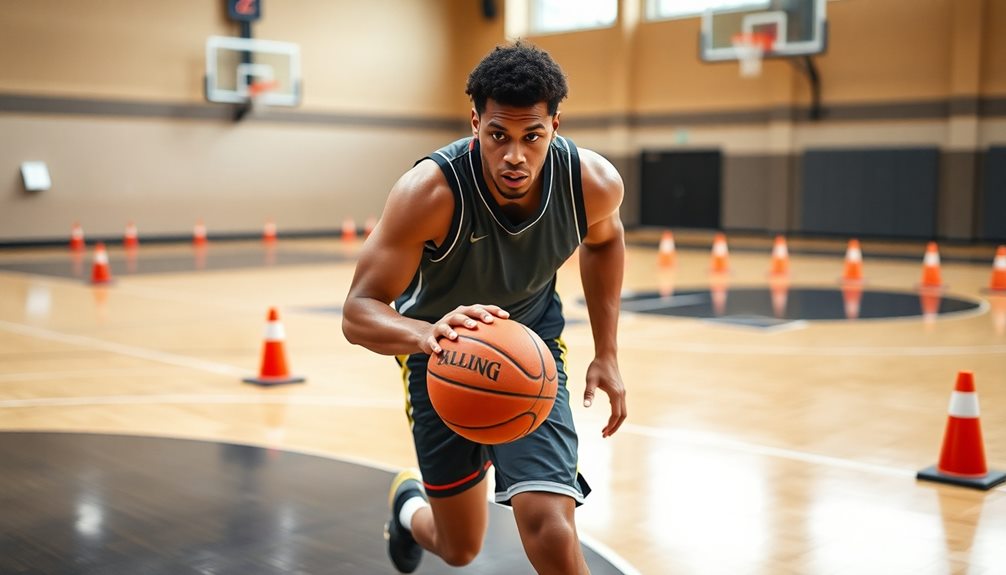
A successful practice philosophy in basketball revolves around pushing your limits and stepping outside your comfort zone. By doing this, you'll be able to develop new skills and tackle challenges in ball handling.
Here are some key elements to keep in mind:
- Consistent, focused practice is vital for mastering ball handling skills. Repeating drills builds muscle memory and boosts your confidence, and incorporating quality training guarantees you develop effective techniques.
- Tracking progress through regular assessments helps you pinpoint areas for improvement and reinforces the importance of goal-setting in your skill development.
- Maintaining a positive mindset during practice fosters resilience. Embrace mistakes as valuable learning opportunities that contribute to your growth.
- Engaging in a variety of drills enhances adaptability and creativity, which are essential for effective ball handling in different game situations.
Drills for All Skill Levels
Building on the practice philosophy that emphasizes pushing your limits, incorporating a variety of drills tailored to all skill levels can markedly enhance your ball handling. The evolution of basketball techniques, including advancements in equipment and player gear, has also influenced how drills are approached in training.
Whether you're a beginner, intermediate, or advanced player, you can benefit from different drill variations designed to suit your current abilities.
As a beginner, start with foundational drills like the pound dribble and figure 8 dribble. These exercises help you build confidence and muscle memory. Once you're comfortable, move on to intermediate drills such as two-ball dribbling and cone dribbling. These will improve your agility and multitasking skills while you handle the ball, similar to how innovations in offensive strategies have revolutionized play styles.
For advanced players, consider high-level drills that simulate game pressure. Incorporating defense during your dribbling exercises and practicing speed dribbling are effective ways to challenge yourself.
Each of these drill variations plays a vital role in enhancing your coordination and control, ultimately leading to improved gameplay effectiveness.
Regular Assessment and Feedback
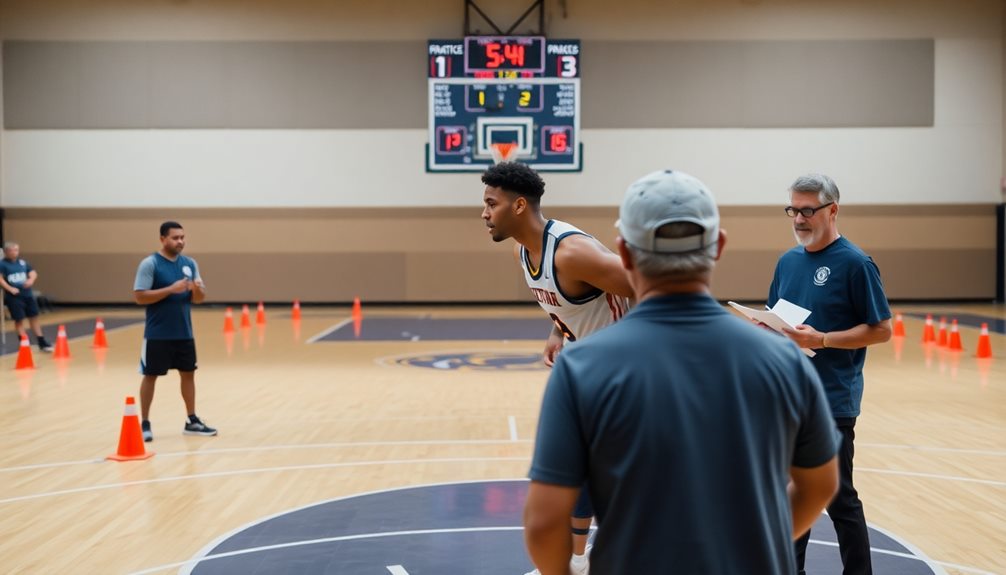
Regularly evaluating your ball handling skills is essential for continuous improvement. To effectively track your skill progression, incorporate regular assessments and feedback into your training routine. This process not only aids in refining your technique but also parallels the way international basketball tournaments enhance players' skills through competitive environments, showcasing the evolution of basketball globally.
Here are some strategies to take into account:
- Time your drills: Regularly assess your dribbling skills by timing yourself to monitor improvements in speed and control over weeks and months.
- Seek feedback: After practice sessions, ask coaches and peers for constructive feedback to pinpoint specific areas needing development.
- Set measurable goals: Create targets, like completing a certain number of successful dribbles or finishing a drill within a specific time frame, to keep your motivation high.
- Use video analysis: Record your practice sessions to visually analyze your technique, allowing you to make adjustments based on identified strengths and weaknesses.
Incorporating these elements into your routine will help you adjust drills or techniques based on your assessments, creating a personalized training plan that addresses your unique skill gaps.
Conclusion
Mastering ball handling is essential for any basketball player aiming to elevate their game. Did you know that players with strong ball handling skills have a 25% higher chance of making successful plays during a game? By consistently practicing the drills and techniques outlined, you'll not only improve your own skills but also boost your confidence on the court. Keep pushing yourself, seek feedback, and remember: great ball handlers aren't born; they're made through dedication and practice!

